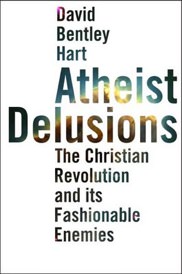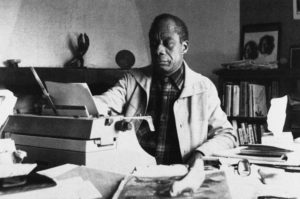Anthony Kenny on ‘Atheist Delusions’
Can traditional Christianity survive the assault of its critics? Has it really been misunderstood and slandered by its cultural despisers?
This review originally appeared in The TLS, whose website is www.the-tls.co.uk, and is reposted with permission.
In the ongoing suit of Secularism vs God, David Bentley Hart is the most able counsel for the defence in recent years. Though confident in the strength of his case, he does not hesitate to abuse the plaintiff’s attorneys, and he does so in grand style. Richard Dawkins is guilty of “rhetorical recklessness”. Christopher Hitchens’s text “careens drunkenly across the pages” of a book “that raises the wild non sequitur almost to the level of a dialectical method”. Daniel Dennett’s theses are “sustained by classifications that are entirely arbitrary and fortified by arguments that any attentive reader should notice are wholly circular”.
Hart [in his book “Atheist Delusions: The Christian Revolution and Its Fashionable Enemies”] has the gifts of a good advocate. He writes with clarity and force, and he drives his points home again and again. He exposes his opponents’ errors of fact or logic with ruthless precision. He is generous in making concessions on his own side, provided they leave intact his overarching claims. Above all, he has ensured that his brief is modest and manageable.
Thus, no attempt is made to plead in defence of religion as such. “Religion in the abstract”, Hart says, “does not actually exist, and almost no one (apart from politicians) would profess any allegiance to it”. This is a sound and fundamental point. The creeds of the major religions are mutually contradictory, so that the one thing we know for certain about religion is that if any religion is true then most religions are false. Hart’s client is not religion in general—it is traditional Christianity. It is this, he claims, that has been misunderstood and slandered by its cultured despisers.
Again, Hart concentrates on issues of history rather than philosophy. True, he claims that Dawkins’s philosophical arguments are ones that “a college freshman midway through his first logic course could dismantle in a trice”. However, the claim that Dawkins is philosophically illiterate is based on an ontology that would be rejected by many a seasoned professor of philosophy. Hart’s own strengths lie elsewhere, so he is wise to concentrate on narrative and invective.
Atheist Delusions: The Christian Revolution and Its Fashionable Enemies
By David Bentley Hart
Yale University Press, 272 pages
The aim of the first half of the book is to demolish “the mythology of a secularist age”. Secularists invite us to believe the following story. In the medieval ages of faith, culture stagnated, science languished, wars of religion were routinely waged, witches were burned by inquisitors, and Western humanity was enslaved to superstition. The literary remains of antiquity had been consigned to the flames, and the achievements of Greek science lay forgotten until Islam restored them to the West. The age of faith was succeeded by an age of reason and enlightenment, which gave us the riches of scientific achievement and political liberty, and a new and revolutionary sense of human dignity. The modern separation of Church and State has put an end to the blood-steeped intolerance of religion. Western humanity has at last left its nonage and attained to its majority in science, politics and ethics. “This is”, Hart says, “a simple and enchanting tale … its sole defect is that it happens to be false in every identifiable detail.” Six chapters demolish detailed elements of this secularist myth. Chapter Four refutes the allegations that the ancient library of Alexandria was destroyed by Christians and that the pagan philosopher Hypatia was murdered out of hatred for women and learning. Chapter Five shows that far from burning Classical texts, Christian monastic librarians preserved them from decay. Chapter Six argues that Greek science had become sterile long before the Christianization of the Roman Empire. The only innovative physicist of late antiquity, we are told, was the Christian John Philoponus. During the four and a half centuries of its scientific pre-eminence, Islam made “no more progress than a moderately clever undergraduate today could assimilate in less than a single academic year”. Paying tribute to the Oxford calculators of the fourteenth century, Hart illustrates the continuity between medieval and Renaissance science. Pope Urban VIII’s condemnation of Galileo, he claims, was not an index of inherent ecclesiastical hostility to science, but a clash of arrogant personalities.
The seventh and eighth chapters defend Christianity from the charges of intolerance and cruelty. The persecution of witches, Hart points out, was an early modern rather than a medieval phenomenon, and the inquisitors of the time did their best to suppress witchhunts.
|
To see long excerpts from “Atheist Delusions,” click here. |
The rise of modern science and the obsession with sorcery “were two closely allied manifestations of the development of a new post-Christian sense of human mastery over the world”. In exculpation of the use of torture and the burning of heretics, it can be said that the Church was merely following a fashion which was originated by the State. During the so-called Dark Ages, the only penalty for misbelief was excommunication, whereas in the heyday of the Holy Roman Empire heresy became a capital crime. “Violence”, Hart says, “increased in proportion to the degree of sovereignty claimed by the state, and whenever the medieval church surrendered moral authority to secular power, injustice and cruelty flourished.”
Addressing the responsibility of the Church for warfare, Hart briskly gets the Crusades out of the way. Admitting that they were “holy wars”—the only ones in Christian history, he maintains—he dismisses them as “the last gaudy flourish of Western barbarian culture, embellished by the winsome ceremonies of chivalry”. The European wars of the sixteenth and seventeenth centuries are treated at greater length. Here, we learn, “no prince of the time waged war against another simply on account of his faith”. In its bloodiest days the Thirty Years War was not a war of religion, but a struggle between two Catholic houses, the Bourbons and the Habsburgs. Hart is at his most convincing when he argues that for the sheer scale of its violence, the modern period trumps any of the ages of Christian faith. “The Thirty Years War, with its appalling toll of civilian casualties, was a scandal to the consciences of the nations of Europe; but midway through the twentieth century … even liberal democracies did not scruple to bomb open cities from the air, or to use incendiary or nuclear devices to incinerate tens of thousands of civilians.”
In the second part of the book, Hart seeks to replace the secularist myth with a positive account of what he calls “the Christian revolution”—”perhaps the only true revolution in the history of the West”. Many of the values prized by modern secularists are inheritances from the early days of Christianity.
Pre-Christian cults involved human sacrifice, self-castration and self-mutilation. PreChristian society despised the poor and weak and tolerated infanticide; it enjoyed gladiatorial combat, and it was built on slavery.
Only Christianity fostered the concept of a dignity intrinsic to every human soul. Only the Church built hospitals and almshouses, and taught that charity was the highest virtue.Well aware that the Christianization of the Roman Empire did not wipe out the evils of pagan society, Hart is generous in concessions to the opposition. He has no illusions about the great Christian emperors. Constantine was “a violent, puritanical, ponderous, late Roman brute”. Theodosius was a harsh persecutor of pagans and heretics. Justinian was one “whom nobody very much liked or likes”. Surprisingly, the one emperor who gets a kind word is Constantine’s apostate nephew Julian, who tried to reintroduce paganism. “Of all the emperors in the Constantinian line Julian alone stands free of any suspicion of bad faith. He was also without question the most estimable and attractive of the lot.” It is wrong, Hart argues, to see Christianity as invading a joyful pagan milieu of vitality and mirth, and turning the world grey with its breath. Late antiquity was an era of fear and melancholy, and contempt for the body was a leitmotif of many of its thinkers. Christianity provided a liberating message, in which the resurrection of Jesus offered hope of the transfiguration of the flesh and the glorification of all creation.
Christianity slowly gave greater freedom to the oppressed of the present world. The legislation of Constantine and Theodosius II improved the status of women, whether virgins, wives or widows. Christian husbands, unlike pagan ones, could not force their wives to submit to abortion or to expose their infants. In the course of Christian history, the foundation of hospitals, leper asylums, almshouses and hostels palliated the lot of the most downtrodden members of society.
Hart cannot deny that the institution of slavery long outlasted Western Europe’s conversion to Christianity. With a shrug, he observes that it is no more surprising that some pagan moral values survived in a Christian culture than that some Christian moral values survive in our secular culture today. He can point to imperial edicts ameliorating the lot of slaves, and he can quote a sermon of St Gregory of Nyssa as early as 379 that attacked slavery as an institution, denouncing as blasphemous the claim of any human being to own another human being.
Atheist Delusions: The Christian Revolution and Its Fashionable Enemies
By David Bentley Hart
Yale University Press, 272 pages
In his final plea for the defence, Hart puts to the jury the question “When Christianity departs, what is left behind?”. The highest ideals of the secular project, he proclaims, are borrowed ideals, and Nietzsche was right that any effort to cast off the Christian faith while retaining the best elements of Christian morality is doomed to defeat. In an ultimate flourish he dons the robes of opposing counsel. “To use Richard Dawkins’s justly famous metaphor (which unfortunately he does not quite grasp is a metaphor), memes like “human rights” and “human dignity” may not indefinitely continue to replicate themselves once the Christian ‘infinite value of every life’ meme has died out.”
Let us now abandon the forensic context, and ask how accurate is Hart’s historical narrative .
The set-piece treatments of the iconic events of secularist propaganda—the burning of the Alexandria library, the Spanish Inquisition, the trial of Galileo and so on—are detailed and often convincing. But the book is full of generalizations that spur the reader to look for—and often to find—counter-examples.
For instance, in expounding the significance of the gospel story of the denial and repentance of Peter, Hart claims that in a pagan world “Peter, as a rustic could not possibly have been a worthy object of a well-bred man’s sympathy”. To say this is to ignore the existence of a whole genre of classical poetry devoted to the joys and sorrows of rustics, namely pastoral elegy.
Frequently, in order to emphasize the originality of Christianity, Hart devalues the achievements of Classical antiquity. Science as we understand it, he claims, depends on Christian underpinning. But if science is the collaborative pursuit of truth about the world by empirical inquiries whose results are structured into a theoretical discipline, then the West’s first centre of scientific research was Aristotle’s Lyceum.
Hart is not at his best when discussing Aristotle.
He cannot have read The History of Animals when he calls Albert the Great “the father of biological field research”. In physics he believes that Aristotle’s prime mover was an outermost crystalline sphere, when in fact it was an incorporeal divinity outside the universe. (How Hart would have crowed if he had come across such a howler in Hitchens!) Hart is right that the discoveries of Copernicus, Kepler, Galileo and Newton were not so much a liberation from religious authority as from latter-day Aristotelianism. But the persistence of Aristotle’s cosmology for many centuries after its sell-by date was partly due to the religious cultures in which it survived. His works became the possession of “peoples of the book”—Muslims, Jews and Christians, and accordingly they were treated in the way that sacred texts are treated. That is why many of the greatest minds of the Middle Ages, instead of following Aristotle’s example of original investigation, wrote commentaries on his scientific works.
Hart’s comparisons between Classical and Christian eras are all too often partisan. In order to portray Christianity as more cheerful than paganism, he has to downplay the patristic teaching that everlasting torment awaited the majority of mankind. To claim that the ultimate equality of all humans is an exclusively Christian doctrine he has to ignore the teaching of Stoics such as the slave Epictetus and the Emperor Marcus Aurelius. To explain his admiration for Julian the Apostate, he has to claim that of all the emperors between Constantine and Theodosius he was the most “genuinely Christian in sensibility”.
The truth is surely that the institutions and values we cherish, like the works of art and architecture that we prize, are not the exclusive property of any one stage in our long history. Some institutions, like democracy, were invented in the ancient world, and others, like universities, date from the Middle Ages. Some values, such as philanthropy, are part of our Judaeo-Christian inheritance: others, such as freedom of speech, we owe to the Enlightenment. Some values and institutions can be credited to more recent times, such as the abolition of slavery and the empowerment of women. Surely, we should be grateful to our ancestors, near and distant, for the good things they handed on to us, and we should do our best to eradicate the evils we have inherited from them. But we can also agree with Hart that to regard our own age as blest beyond all others with an overplus of good versus evil is the height of folly.
© Copyright of the Newspaper Licensing Agency.
|
Anthony Kenny is a former Master of Balliol College, Oxford. He is the author of the four volumes of Oxford University Press’ “New History of Western Philosophy,” published from 2004 to 2008. |
With an uncertain future and a new administration casting doubt on press freedoms, the danger is clear: The truth is at risk.
Now is the time to give. Your tax-deductible support allows us to dig deeper, delivering fearless investigative reporting and analysis that exposes what’s really happening — without compromise.
Stand with our courageous journalists. Donate today to protect a free press, uphold democracy and unearth untold stories.







You need to be a supporter to comment.
There are currently no responses to this article.
Be the first to respond.